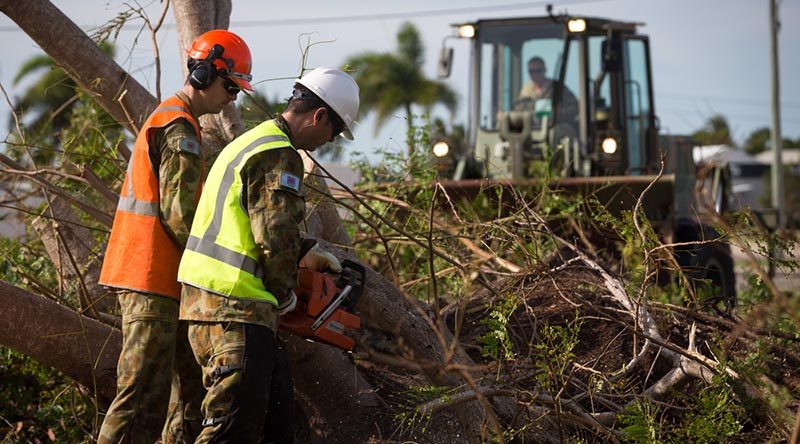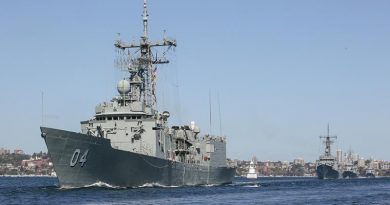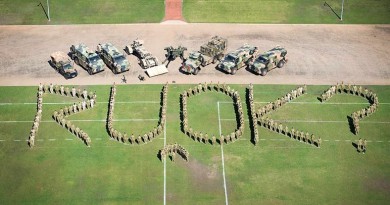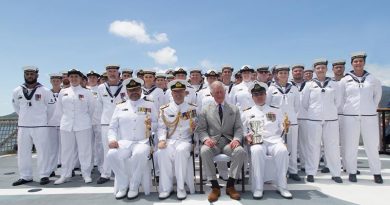Operation Queensland Assist – 3 April UPDATE

The cyclone-recovery mission in north Queensland continues with the engineer-heavy Joint Task Force 661 spearheading ADF effort.
CAPTION: Corporal Brendan Bayly and a colleague from 3rd Combat Engineer Regiment, cuts up a fallen tree in Bowen, Queensland, in the wake of Tropical Cyclone Debbie. Photo by corporal David Said.
Joint Task Force 661 is the ADF response to support local and state authorities with the recovery following Tropical Cyclone Debbie which hit the Whitsunday Coast on 28 March 2017.
Operation Queensland Assist 2017 provided support to disaster affected areas following the cyclone in accordance with existing Defence Assistance to the Civil Community (DACC) arrangements and regionally as part of Whole of Government response.
The Emergency Support Force is led by Lieutenant Colonel Jennifer Harris Commanding Officer of the 3rd Combat Engineer Regiment and consists of personnel from units from Townsville’s 3rd Brigade.
![]()
Minister for Defence Marise Payne, who travelled with Minister for Justice Michael Keenan to Queensland today to meet with Australian Defence Force personnel who are providing support for communities devastated by Tropical Cyclone Debbie said the Australian government was unreservedly committed to supporting communities affected by natural disasters – we always have and always will.
Accompanied by Chief of the Defence Force Air Chief Marshal Mark Binskin, the ministers met with community representatives and saw first-hand the recovery efforts underway in Proserpine and Airlie Beach.
Minister Payne said the Australian Defence Force was providing humanitarian assistance and disaster relief across the affected regions, with approximately 1600 ADF personnel assigned to Operation Queensland Assist 17.
“ADF personnel have helped clear roads, ports and beaches, deliver medical personnel and supplies into cut-off areas, assess damage from the air and sea, and distribute water,” Senator Payne said.
“HMAS Choules arrived in the Whitsundays late Friday night and delivered much needed emergency stores and equipment to those communities over the weekend.”
Minister Keenan said nature had flung its worst at Queensland this week and the emergency response was not over yet.
“Even the most resilient community was going to reel under destruction, rain and flooding of this magnitude,” Mr Keenan said.
“I was proud to witness the positive spirit of local residents and community camaraderie despite the hardship they have endured.
“People from all parts of the community have pitched in to the recovery efforts, supported by emergency services personnel and the hardworking men and women from the ADF, who have done a heroic job in assisting those in need.”
To help the affected communities get back on their feet, assistance has been made available under the jointly funded Commonwealth-State Natural Disaster Relief and Recovery Arrangements (NDRRA).
The Australian government has also activated both the Disaster Recovery Payment and the Disaster Recovery Allowance for eligible residents in the Whitsunday local-government area.
The Disaster Recovery Payment (DRP) provides a one-off, non-means tested recovery payment of $1000 for eligible adults and $400 for eligible children.
It is generally available for people who have been seriously injured or whose home has been destroyed or suffered significant damage.
The Disaster Recovery Allowance (DRA) is a short-term income support payment to assist individuals who can demonstrate that their income has been affected as a direct result of the disaster.
The Australian government says it will continue to monitor the impacts of Tropical Cyclone Debbie and liaise with the Queensland State government regarding recovery assistance.
.
.
.
.
.
.
.

.
.







